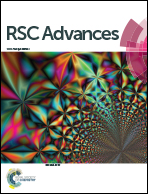Towards Si@SiO2 core–shell, yolk–shell, and SiO2 hollow structures from Si nanoparticles through a self-templated etching–deposition process†
Abstract
Si@SiO2 core–shell, yolk–shell, and SiO2 hollow structures can be obtained when Si nanoparticles are simply treated with ammonia–water–ethanol solution at room temperature. Their formation mechanism is attributed to the self-templated etching–deposition process.


 Please wait while we load your content...
Please wait while we load your content...